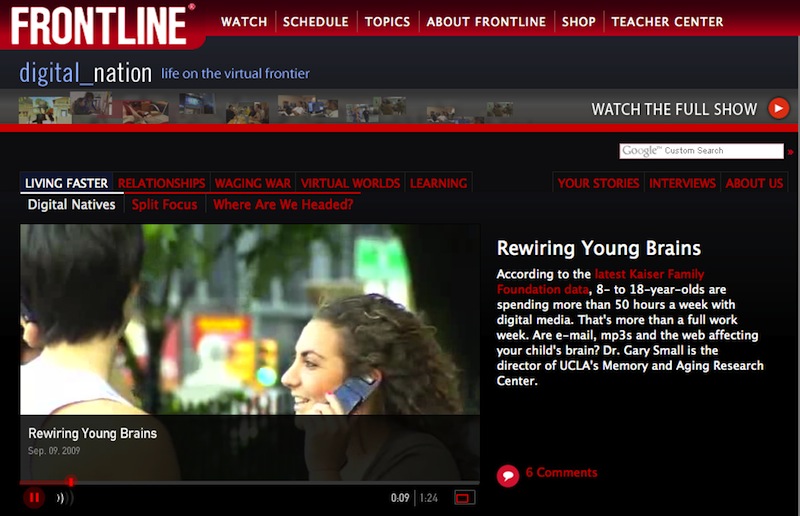Cycle (part 2/2): Academic Legitimation and Changing Brains as Evidence
<< Digital Nation legitimizes claims for changes in the materiality of literacy practice (both as decline and progression) through neuroscientific evidence and images of the brain that result from brain scans and other imaging technologies. To be more precise, the neuroscientific studies cited in Digital Nation do not purport to directly measure literacy ability. Instead, they measure activities and performances (like relationships between multitasking and productivity, for instance) that then become connected to claims about literacy by association. This move has become common in scholarship that explores the cognitive effects of technology use by scholars inside and outside disciplines like cognitive psychology (see Carr, Davidson, Wolf). For example, Hayles navigates a great deal of neuroscientific material to argue for the binary of “hyper” and “deep” models of attention as generational preferences. Although she initially cites John Bruer’s cautionary tale that education specialists should be wary of making pedagogical decisions from “basic brain research,” she later argues that “brain imaging studies are changing that situation, because they allow correlations between observable actions—what the subjects are doing at the time the image is taken—and metabolic processes in the brain” (192). To support her assertions about hyper and deep attention and their relationship to reading and writing ability, Hayles draws on Michael Posner’s brain research that argues that younger individuals’ brains are changing as a result of extended video game play.
By highlighting the role of brain imaging in contemporary representations of distraction, I do not mean to initiate a critique of neuroscience from the outside. Instead, I hope to identify neuroscientific evidence as a new and important actor in the discourse that creates literacy crisis so that we can begin the work of understanding how it functions rhetorically with respect to our conceptions of literacy. Recent research in neurorhetorics asks rhetorical scholars to weigh how neuroscientific arguments construct authority (see Gruber et. al; Jack and Appelbaum; Mays and Jung). It is also important for rhetorical scholars to position and analyze neuroscientific evidence within the historical trajectories of the interdisciplinary discursive arenas that it enters. For example, Trimbur argues that literacy crisis rhetoric tends to be substantiated by evidence that is difficult to refute. In particular, “Test results … possess a kind of facticity that appears to put them above question and beyond interpretation. They appear, that is, to offer self evident accounts of literacy crises—of deteriorating educational standards and declining student performances” (282). Read within the historical cycles of crisis discourse that Trimbur identifies, the move to brain imaging can be read as another turn toward irrefutable evidence.
What Role Does Neuroscience Play in the Discourse that Creates Crisis?
Neuroscientific evidence is a particularly fitting actor for the contemporary discourse that creates crisis because it responds to the problems that unruly bodies engaged in non-school-related literacy pose for literacy as a schooled, measurable, cognitive skill. By positioning the locus of meaningful activity not in the cognitive mind but in the biological brain, neuroscientific evidence can have the effect of suggesting that the most important impacts of digital literacy practice are not those that take place within social and cultural communities of practice but instead within the physical brains of individual practitioners. This move once more positions the student body as docile in Foucault’s terms by bypassing the operations of the active body while constructing the brain as a passive physical apparatus continually rewritten by technological forces. This rhetorical move frequently casts brains in technological language, as when Digital Nation worries about whether access to the web is "rewiring" young people's brains (transcript paragraphs 95-107).
A similar language and attitude is foundational to Nicholas Carr’s now well-known introduction to The Shallows, in which he describes his “uncomfortable sense that someone, or something, has been tinkering with my brain, remapping the neural circuitry, reprogramming the memory” (5). We might even suggest that it is also behind public worries about how the effects of technological changes such as teaching keyboarding instead of cursive writing in public schools will diminish cognitive capacity. While there is much to be learned from current brain science, even cognitive psychologist Steven Pinker, a staunch defender of the biological nature of mind and language, has taken issue with Carr’s arguments about the effects of the Internet on the brain, suggesting that “cognitive neuroscientists roll their eyes at such talk” and urging that the “solution is not to bemoan technology but to develop strategies of self-control” (n.p.) Importantly, Howard Rheingold in Net Smart similarly worries about the technologically deterministic warrants of Carr’s argument and calls for the exercise of human agency in constructing “mindfulness” toward the use of new technologies through acts of self-initiated training (and indeed by helping students learn new techniques for attention in academic classrooms).
How Can We Respond?
For literacy educators teaching students who have grown up digital, it is important to acknowledge the power that comes from being part of institutions that shape literacy technique and knowledge. While there is certainly an important place for neuroscientific research in these conversations, I am asking educators to be cautious about drawing on this form of evidence to widen a perceived gap between "us" and "them" without also looking to cultural and social contexts of literacy practice and technology use. By constructing students as pervasively distracted, we risk participating in discourse that positions students as lacking agency with respect to their own habits of engagement. It would be a shame for this to happen at such an opportune moment, when Eliza’s emblematic image offers an opportunity to argue for the importance of self-sponsored and community-based literacies and to help students learn from and about them. >>
